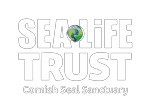The hospital has welcomed its first rescued grey seal pup of the season; a young female pup affectionately named S’mores, in line with this year’s naming theme of ‘Cakes and Desserts’.
S’mores, thought to be just 4–5 weeks old, was rescued by BDMLR volunteers from Crackington Haven, near Bude. She was severely malnourished with several puncture wounds, and after being carefully monitored and stabilised by medics, she was brought into the Sanctuary’s expert care.
The little pup spent a few days in our isolation unit, before progressing to the hospital pens, where she is recovering well.
While S’mores is the first pup to graduate through to the on-view hospital pens, she wasn’t our first rescue this season. Sadly, another very young pup named Banoffee, who arrived at the end of August, developed a suspected septicaemia, and despite the team’s best efforts, didn’t survive. This is a reminder of how tough life can be for a wild seal pup and why the work we do is so vital.
“Seal pup season can be full of highs and lows, said Megan Gunnell, Senior Animal Care Specialist. Although it’s always heartbreaking when a pup doesn’t make it, each rescue gives us a chance to help many more pups like S’mores”
Visitors can see S’mores during their visits, but we are asking everyone to be mindful and keep quiet around her enclosure to avoid causing any stress or disturbance while she continues her recovery.
“We’re so pleased with how S’mores is doing, she came in very weak and underweight, but she’s showing real determination, she has already started to feed herself, which is a great sign”, said Megan Gunnell, Senior Animal Care Specialist at the Cornish Seal Sanctuary.
“It’s still early days for her, so the best way the public can help is by keeping noise to a minimum when visiting, giving her the calm space she needs to grow stronger before she can return to the wild.”
The cost of Care
On average, it costs the Sanctuary around £2000 to rescue, rehabilitate and release a single seal pup.
“Every visit and donation to our Sanctuary really does make a huge difference”, said Jasmine Chater, Fundraising Co-ordinator at the Cornish Seal Sanctuary. “With rising costs of food, medicines and supplies, pup season is becoming increasingly challenging.”
As a charity, we rely on the generosity of our visitors and supporters to continue our vital work. There are many ways that people can help, from visiting, sponsoring a seal pup, leaving a donation in a will or fundraising, to simply spreading awareness about how to act responsibly around wild seals.
Jasmine continues, “Our supporters mean the world to us, without them, we simply couldn’t give pups like S’mores the second chance they deserve”.
Each pupping season (typically September-March), we care for dozens of vulnerable grey seal pups that need medical attention and rehabilitation before being released back into the wild. S’mores is the first of many who will rely on our specialist team over the coming months.
What to Do if You Spot a Seal Pup
With pup season now underway, here's a reminder of what to do if you spot a seal pup on the beach:
- Keep your distance – Stay well back and keep dogs on leads.
- Never approach, touch, or chase a pup – even if it looks alone.
- Observe quietly – Noise and disturbance can be very stressful for seals.
- Call for advice – If you’re concerned about a pup’s condition, contact the British Divers Marine Life Rescue (BDMLR) hotline on 01825 765546.

